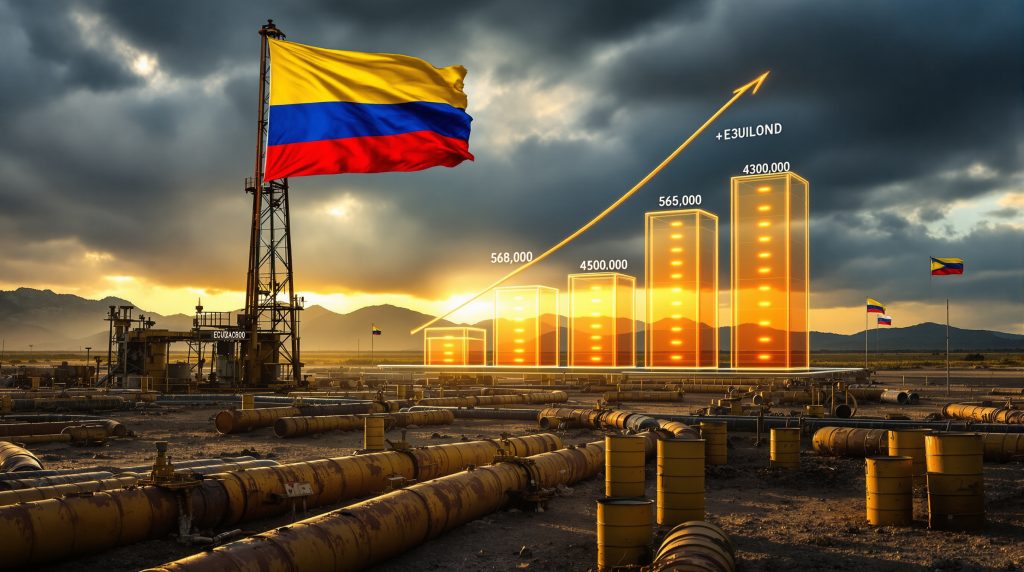Ecuador's Production Collapse: A Manufacturing Crisis in South America's Energy Sector
Ecuador's petroleum industry faces an unprecedented collapse that extends far beyond typical market fluctuations. The nation's energy sector has experienced a systematic breakdown across multiple operational dimensions, creating ripple effects throughout South American energy markets and highlighting vulnerabilities in regional supply chains.
The magnitude of Ecuador's declining oil output represents more than statistical decline. It signals fundamental structural problems within one of South America's historically significant energy producers, with implications reaching from local communities dependent on petroleum revenue to international markets relying on consistent regional supply.
Infrastructure Deterioration Drives Operational Failures
Ecuador's petroleum infrastructure suffers from decades of inadequate maintenance and investment, creating a cascade of operational failures that compound production challenges. The country's pipeline network, once capable of handling substantial throughput volumes, now operates at severely reduced capacity due to corrosion, equipment failures, and safety concerns.
Critical Infrastructure Metrics:
- Historical peak production: 556,554 barrels per day (2014)
- November 2019 peak: 555,228 barrels per day
- Current average output: 430,542 barrels per day (first nine months 2025)
- September 2025 production: 468,295 barrels per day
Furthermore, the Sacha field complex, historically Ecuador's largest production contributor, currently operates at zero output due to pipeline infrastructure constraints. This complete shutdown of a major production facility illustrates the severity of Ecuador's infrastructure crisis and its immediate impact on national petroleum output.
Security Threats and Violence Impact Operations
Ecuador's transformation into a major narcotics transshipment hub has created unprecedented security challenges for petroleum operations. The country's homicide rate has surged to 39 murders per 100,000 inhabitants, representing nearly a sixfold increase over the past five years.
This security deterioration directly affects petroleum infrastructure through:
- Targeted attacks on pipeline systems and production facilities
- Workforce safety concerns limiting operational capacity
- Transportation disruptions affecting supply chain logistics
- Increased operational costs for security measures
Consequently, the violence associated with organised crime networks has forced temporary shutdowns of key production sites across multiple regions, creating additional volatility in an already unstable production environment. Moreover, these developments have contributed to broader concerns about oil price stagnation & opec dynamics in the region.
Investment Drought Compounds Operational Challenges
International capital flows into Ecuador's energy sector have diminished substantially since 2020, reflecting investor concerns about political stability, regulatory uncertainty, and operational security. The combination of these factors has created an investment environment that deters both exploration activities and infrastructure modernisation projects essential for production recovery.
Foreign investment partnerships, historically crucial for Ecuador's energy sector development, now face significant barriers including:
- Political instability affecting long-term project planning
- Regulatory changes creating uncertainty about operational frameworks
- Security risks increasing project costs and complexity
- Global market volatility reducing investor appetite for higher-risk projects
Additionally, global trends such as the us drilling activity decline have influenced international investor sentiment towards higher-risk petroleum projects.
Current Production Reality: Statistical Analysis
Ecuador's declining oil output statistics reveal the depth of the industry's decline across all major operational categories. The data demonstrates not merely cyclical downturn but systematic operational deterioration affecting the country's energy production capacity.
| Production Metric | Current Level | Historical Peak | Percentage Decline |
|---|---|---|---|
| Daily Average (2025) | 430,542 bpd | 556,554 bpd (2014) | 22.6% |
| September 2025 | 468,295 bpd | 555,228 bpd (Nov 2019) | 15.6% |
| Annual Estimate 2025 | 465,369 bpd | 556,554 bpd (2014) | 16.4% |
Block-Specific Performance Analysis
Block 43 (Yasuni National Park):
- Current production capacity: 55,000 barrels per day
- Annual output: 20 million barrels
- Operational status: Gradual closure initiated
- Operator: Petroecuador (national oil company)
The impending closure of Block 43 represents a significant production loss with no identified replacement capacity. This closure, driven by environmental considerations, will eliminate 20 million barrels of annual production, further constraining Ecuador's already diminished output capacity.
Monthly Production Trends
September 2025 production figures show marginal stability compared to the previous year, with output reaching 468,295 barrels per day versus 469,232 barrels per day in September 2024. However, this apparent stability masks the underlying structural problems preventing sustainable production growth.
The 2025 annual production estimate of 465,369 barrels per day represents the lowest petroleum output in over two decades, highlighting the persistence of operational challenges affecting Ecuador's declining oil output.
Regional Comparative Analysis: South American Context
Ecuador's production challenges occur within a broader South American energy landscape characterised by varying levels of operational stability and infrastructure investment. Understanding Ecuador's position relative to regional producers provides context for the significance of its production decline.
Comparative Regional Performance
Colombia's Stability Factors:
Colombia maintains relatively stable production levels despite facing similar security challenges. The country benefits from diversified pipeline infrastructure and stronger international partnerships, providing operational resilience that Ecuador currently lacks.
Peru's Operational Consistency:
Peru experiences moderate production fluctuations but maintains more consistent operational capacity through better infrastructure maintenance and greater political stability, factors that have helped maintain investor confidence.
Venezuela's Parallel Challenges:
Venezuela, despite possessing larger hydrocarbon reserves, faces comparable production challenges due to economic sanctions and infrastructure deterioration. This parallel situation demonstrates how political and economic factors can override resource advantages.
Regional Supply Chain Implications
Ecuador's production decline affects regional refining operations and trading patterns, particularly impacting countries that historically relied on Ecuadorian crude for specific refinery configurations. These supply chain disruptions force affected nations to seek alternative suppliers or adjust processing parameters, creating additional costs and operational complexity.
In addition, the situation has broader implications for oil price movements in trade wars and regional energy security considerations.
Economic Crisis: Fiscal and Debt Implications
The petroleum sector's decline creates cascading effects throughout Ecuador's economy, given oil's central role in government finances and export earnings. The magnitude of these economic consequences extends beyond simple revenue reduction to fundamental questions about fiscal sustainability.
Oil's Economic Significance
Key Economic Indicators:
- Export contribution: Approximately 30% of total export value
- Government revenue: Around one-third of total fiscal income
- GDP contribution: 7.5% of national gross domestic product
These figures underscore petroleum's crucial role in Ecuador's economic structure and explain why production declines have such severe fiscal implications.
Fiscal Crisis Development
2025 Fiscal Performance:
- Fiscal deficit: 4.4% of GDP (September 2025)
- Original deficit forecast: 2% of GDP
- Revenue coverage: Oil and tax revenues cover only 70% of planned expenditures
- Total revenue shortfall: $14 billion for first nine months of 2025
Former Minister of Economy Mauricio Pozo projects the fiscal deficit could reach $4.6 billion, equivalent to 4% of Ecuador's GDP and nearly double the IMF-mandated 2% target. This projection suggests continuing fiscal deterioration without significant policy intervention or production recovery.
Public Debt Crisis
Debt Metrics:
- Total public debt: $80 billion
- Debt-to-GDP ratio: 62%
- IMF facility utilisation: $6.6 billion drawn by end of September 2025
- IMF facility limit: $5 billion (increased from original $4 billion)
Economic analysts consider Ecuador's 62% debt-to-GDP ratio as placing the country on the verge of insolvency, particularly given declining fiscal revenues and increasing expenditure pressures related to security challenges.
Chinese Debt Complications
Oil-Backed Loan Details:
- Total Chinese oil-backed debt (early 2022): $4.4 billion
- China Development Bank debt: $1.4 billion (maturity extended to 2027)
- Export-Import Bank of China debt: $1.8 billion (maturity extended to 2032)
- Estimated debt relief (2022 renegotiation): $1.4 billion
Prior to 2022 renegotiations, approximately 90% of Ecuador's oil exports were committed to China under terms that allowed Beijing to pay significantly below international market prices. Some Chinese firms subsequently sold this oil on international markets at profit, creating additional revenue loss for Ecuador.
The 2022 debt renegotiation provided temporary relief, but declining oil production means fewer cargoes available for market-price sales, reducing the benefits of these improved terms.
Additional Financing Pressures
Recent Additional Loans:
- PowerChina renewable energy loan: $400 million
- Inter-American Development Bank security loan: $400 million (June 2025)
- IMF facility augmentation: Additional $1 billion capacity
- IMF immediately accessible funds: Additional $600 million
These additional financing arrangements demonstrate Ecuador's desperate fiscal position and the international community's recognition of the country's financial crisis.
Recovery Prospects: Challenges and Opportunities
Despite Ecuador's current production challenges, several potential pathways exist for energy sector recovery, though each faces significant implementation obstacles and requires substantial investment commitments.
Government Recovery Initiative
President Noboa's Recovery Plan:
- Total investment commitment: $47 billion
- Revised 2025 production target: 465,369 barrels per day
- Original 2025 target: Over 500,000 barrels per day
The substantial reduction in production targets from original forecasts indicates the government's recognition of operational constraints and the difficulty of rapid production recovery.
Infrastructure Modernisation Requirements
Priority Investment Areas:
- Pipeline system rehabilitation: Comprehensive overhaul of main transport arteries
- Secondary transport networks: Upgrades to regional distribution systems
- Storage facility modernisation: Enhanced capacity and safety systems
- Security infrastructure: Advanced monitoring and protection systems
The estimated investment requirements exceed several billion dollars, necessitating either substantial government funding or attractive terms for private investors. Given Ecuador's fiscal constraints, international partnerships appear essential for meaningful infrastructure modernisation.
Furthermore, these challenges occur within a broader context where regions like alaska drilling policy shift demonstrate how policy changes can affect regional energy development prospects.
Technology Integration Solutions
Advanced monitoring systems, predictive maintenance technologies, and enhanced security infrastructure could improve operational efficiency whilst reducing vulnerability to disruptions. However, implementing these technologies requires both capital investment and technical expertise that may need international support.
Technological Enhancement Opportunities:
- Predictive maintenance systems to prevent infrastructure failures
- Advanced security monitoring to protect critical installations
- Operational optimisation software to maximise production efficiency
- Remote monitoring capabilities to reduce personnel risks
Global Market Response and Regional Implications
Ecuador's declining oil output occurs within a complex global oil market environment where supply disruptions from smaller producers can have localised but significant impacts on regional energy security and pricing patterns.
Regional Supply Chain Disruptions
Reduced Ecuadorian crude exports affect regional refining operations and trading patterns. Countries that historically relied on Ecuadorian petroleum for specific refinery configurations must now seek alternative suppliers or adjust processing parameters, creating additional costs and operational complexity.
Market Adaptation Challenges:
- Refinery configuration adjustments to accommodate different crude types
- Alternative supplier identification and contract negotiation
- Transportation cost increases from more distant supply sources
- Supply chain reliability concerns affecting long-term planning
Price Impact Analysis
Whilst Ecuador's production represents a relatively small percentage of global supply, regional price differentials and shipping costs create market segments where Ecuadorian crude holds particular value. Production losses in these specialised market niches can generate disproportionate price effects for regional consumers.
These dynamics are particularly relevant in the context of broader oil price rally & tariffs considerations affecting global energy markets.
Strategic Reserve Considerations
Some importing nations view Ecuador's production challenges as highlighting the importance of diversified supply sources and strategic petroleum reserves for energy security planning. This recognition may influence future energy policy decisions and supply chain management strategies.
Energy Transition Implications and Future Planning
Ecuador's oil sector crisis intersects with broader global energy transition trends, creating both challenges and opportunities for the country's long-term energy strategy and economic development planning.
Renewable Energy Development Context
Current Renewable Investment:
- PowerChina renewable energy loan: $400 million for hydroelectric and solar projects
Reduced oil revenues could theoretically accelerate Ecuador's focus on renewable energy development, particularly hydroelectric and solar projects where the country possesses natural advantages. However, immediate fiscal constraints limit available investment capital for substantial energy transition initiatives.
Economic Diversification Imperatives
The petroleum sector's decline underscores the urgent need for economic diversification beyond extractive industries. This transition requires:
- Alternative economic sector development to reduce oil dependence
- Infrastructure investment in non-petroleum industries
- Educational and technical capacity building for economic transition
- International partnership development for technology transfer and investment
Carbon Policy and Environmental Considerations
Environmental pressures that contribute to oil sector challenges also create opportunities for Ecuador to position itself as a leader in sustainable development practices, potentially attracting international climate finance and environmental partnerships.
Environmental Policy Opportunities:
- International climate finance access for sustainable development projects
- Carbon credit generation through forest conservation and renewable energy
- Sustainable development leadership positioning for international support
- Environmental tourism development as alternative revenue source
Market Psychology and Investment Dynamics
The psychological aspects of Ecuador's energy crisis extend beyond immediate operational concerns to broader questions about investor confidence, regional stability, and long-term energy security planning.
Investor Confidence Factors
International investors evaluate Ecuador's energy sector through multiple risk lenses, including political stability, regulatory consistency, operational security, and fiscal policy predictability. The convergence of challenges across these dimensions creates a particularly difficult environment for attracting necessary investment capital.
Investment Risk Assessment:
- Political risk: Electoral cycles and policy continuity concerns
- Operational risk: Security threats and infrastructure reliability
- Regulatory risk: Changing environmental and taxation policies
- Market risk: Oil price volatility and global energy transition trends
Regional Contagion Concerns
Ecuador's energy sector problems raise concerns about potential regional contagion effects, where investors become more cautious about South American energy investments generally, potentially affecting regional capital flows and development financing.
However, experts note that Ecuador's declining oil production faces mounting challenges whilst Ecuador's oil industry continues to struggle with environmental setbacks, creating additional uncertainty for potential investors.
Technical Analysis: Production Optimisation Challenges
Ecuador's production optimisation faces technical challenges that extend beyond simple infrastructure repair to fundamental questions about reservoir management, extraction technology, and operational efficiency.
Reservoir Management Issues
Many of Ecuador's oil fields require sophisticated enhanced oil recovery techniques to maintain production levels. The lack of investment in these technologies, combined with infrastructure constraints, limits the country's ability to optimise production from existing reserves.
Technical Enhancement Requirements:
- Enhanced oil recovery systems for mature field optimisation
- Water injection technology for reservoir pressure maintenance
- Horizontal drilling capabilities for improved extraction efficiency
- Real-time monitoring systems for production optimisation
Geological Factors and Reserve Quality
Ecuador's petroleum reserves include both conventional and more challenging deposits that require specialised extraction techniques. The country's ability to access these reserves depends on having appropriate technology and infrastructure, both currently constrained by investment limitations.
Long-term Strategic Implications
Ecuador's energy crisis represents more than a temporary production challenge. It signals fundamental shifts in the country's economic structure and highlights the risks associated with heavy dependence on extractive industries.
Economic Restructuring Necessity
The persistence of production challenges suggests Ecuador must develop alternative economic foundations that reduce dependence on petroleum revenues. This restructuring requires coordinated policy responses addressing:
- Economic diversification strategies beyond extractive industries
- Human capital development for alternative economic sectors
- Infrastructure investment supporting non-petroleum economic activities
- International partnership development for technology transfer and market access
Regional Leadership Opportunities
Despite current challenges, Ecuador's situation creates opportunities for regional leadership in sustainable development and energy transition planning. The country could leverage its environmental assets and renewable energy potential to attract international support for alternative development pathways.
Conclusion: Navigating Complex Recovery Challenges
Ecuador's declining oil output represents a convergence of infrastructure deterioration, security challenges, investment constraints, and fiscal pressures that together create one of South America's most complex energy sector crises. The situation extends beyond temporary operational difficulties to fundamental questions about economic structure and development strategy.
The path toward recovery requires addressing multiple interconnected challenges simultaneously. Infrastructure modernisation, security improvements, fiscal policy adjustments, and investment attraction all need coordinated attention. However, Ecuador's current fiscal constraints and debt burden limit the government's ability to fund necessary improvements independently.
International partnerships appear essential for meaningful recovery, but these partnerships require political stability and regulatory clarity that Ecuador has struggled to maintain. The success of President Noboa's $47 billion recovery plan depends on overcoming these fundamental governance and investment climate challenges.
For regional energy markets, Ecuador's experience demonstrates how quickly energy sector capabilities can deteriorate when multiple risk factors converge. The situation serves as a cautionary example for other producing nations and highlights the importance of consistent infrastructure investment and political stability for energy sector sustainability.
The resolution of Ecuador's energy crisis will likely determine the country's economic trajectory for years to come. Success requires balancing immediate production recovery needs with longer-term sustainability considerations, whilst managing fiscal constraints and social pressures that continue to complicate policy implementation.
Disclaimer: This analysis is based on publicly available information and should not be considered as financial or investment advice. Oil production figures, economic data, and political developments can change rapidly, and readers should verify current information before making investment or business decisions related to Ecuador's energy sector.
Looking to Invest in Energy Sector Opportunities?
Discovery Alert's proprietary Discovery IQ model delivers real-time alerts on significant ASX mineral discoveries, instantly empowering subscribers to identify actionable opportunities ahead of the broader market. Begin your 30-day free trial today and secure your market-leading advantage whilst Ecuador's energy crisis creates global supply chain shifts that may benefit Australian mining companies.




